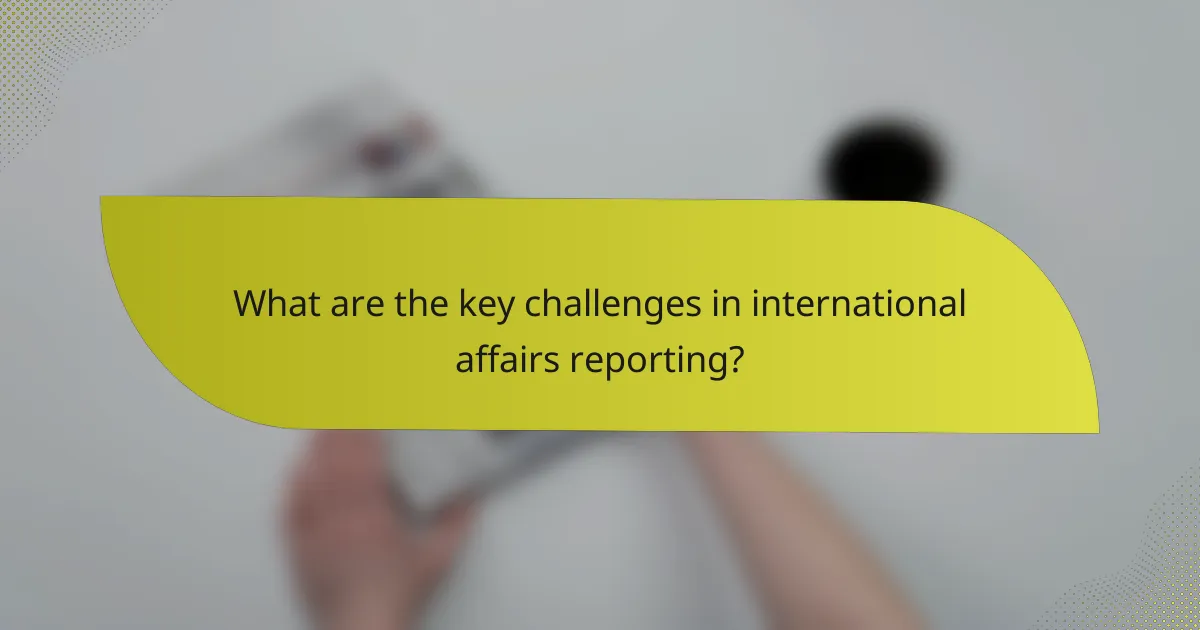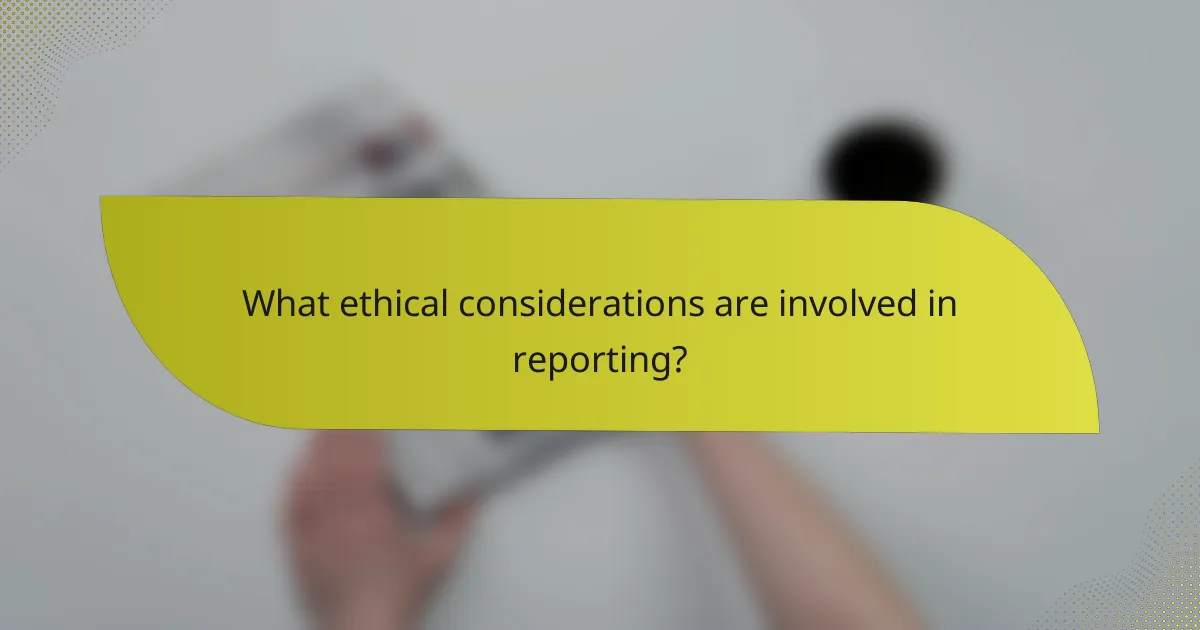Editorial choices play a crucial role in shaping international affairs reporting, influencing which stories are highlighted and how they are framed. These decisions not only affect public perception but also reflect the underlying values of the media outlets. Additionally, challenges such as information reliability and language barriers further complicate the landscape of global news coverage.

How do editorial choices impact international affairs reporting?
Editorial choices significantly shape international affairs reporting by determining which stories are told and how they are presented. These decisions influence public perception and understanding of global events, often reflecting the values and priorities of the media outlet.
Selection of sources
The selection of sources is crucial in international affairs reporting, as it affects the credibility and diversity of perspectives presented. Journalists often rely on a mix of official statements, expert opinions, and grassroots voices to provide a well-rounded view. However, over-reliance on certain sources, such as government officials or corporate representatives, can lead to biased narratives.
To ensure balanced reporting, journalists should aim to include a variety of sources, representing different viewpoints and backgrounds. This may involve seeking out local journalists, NGOs, or community leaders who can offer insights that mainstream sources might overlook.
Framing of narratives
Framing involves how stories are structured and the context provided, which can significantly influence audience interpretation. For instance, describing a conflict as a “civil war” versus an “uprising” can evoke different emotional responses and political implications. The choice of language and emphasis on specific details can steer public opinion in subtle yet powerful ways.
Reporters should be mindful of their framing techniques and strive for neutrality, presenting facts without loaded language. Using clear, objective terms and providing context can help audiences form their own conclusions rather than being swayed by the reporter’s perspective.
Influence of political bias
Political bias in international affairs reporting can manifest through editorial choices that favor certain ideologies or political agendas. This bias may be reflected in story selection, language, and the portrayal of events and actors. For example, a media outlet with a particular political leaning may emphasize negative aspects of a rival country’s policies while downplaying similar issues in a friendly nation.
To mitigate the effects of bias, journalists should adhere to ethical standards of fairness and accuracy. Engaging in fact-checking, presenting multiple viewpoints, and disclosing potential conflicts of interest can help maintain journalistic integrity and foster trust with the audience.

What are the key challenges in international affairs reporting?
International affairs reporting faces several key challenges, including the need for reliable information, overcoming language barriers, and ensuring the safety of journalists. These factors significantly impact the quality and accuracy of news coverage in a global context.
Access to reliable information
Accessing reliable information is crucial for accurate international reporting. Journalists often rely on local sources, government statements, and international organizations, but these can vary in credibility. Verifying facts through multiple channels is essential to avoid misinformation.
In regions with limited press freedom, obtaining trustworthy information can be particularly difficult. Reporters may need to develop relationships with local informants or utilize technology to bypass censorship, which can be risky but necessary for comprehensive coverage.
Language barriers
Language barriers pose significant challenges in international affairs reporting. Journalists may encounter difficulty in understanding local dialects or nuances, which can lead to misinterpretation of critical information. Employing skilled translators or learning key phrases in the local language can help mitigate this issue.
Additionally, the use of jargon or culturally specific terms can complicate communication. Reporters should strive to clarify complex concepts and ensure their audience comprehends the context of the information being reported.
Safety of journalists
The safety of journalists is a paramount concern in international affairs reporting. Many journalists operate in conflict zones or authoritarian regimes where they face threats, harassment, or violence. Organizations like the Committee to Protect Journalists (CPJ) provide resources and support to enhance reporter safety.
To navigate these dangers, journalists should prioritize their safety by following established protocols, such as conducting risk assessments and maintaining communication with trusted contacts. Awareness of local laws and customs is also vital to minimize risks while reporting in sensitive areas.

How do different media outlets approach international affairs?
Different media outlets have distinct editorial choices and narrative styles when covering international affairs, influenced by their target audiences and cultural contexts. These approaches can shape public perception and understanding of global events significantly.
Comparative analysis of CNN and BBC
CNN and BBC both report on international affairs but differ in their narrative framing and presentation style. CNN often emphasizes breaking news and real-time updates, appealing to a fast-paced audience, while BBC tends to provide in-depth analysis and context, reflecting its public service mandate.
For example, during major global events, CNN may focus on live coverage and viewer engagement through social media, whereas BBC might prioritize comprehensive reports that include historical context and expert opinions. This difference can affect how audiences perceive the urgency and significance of the news.
Differences in coverage by Al Jazeera
Al Jazeera’s coverage of international affairs often highlights perspectives from the Global South, which can contrast sharply with Western media narratives. This outlet focuses on underreported issues, particularly in the Middle East and North Africa, providing a voice to marginalized communities.
For instance, Al Jazeera may cover protests or conflicts in a way that emphasizes local voices and grassroots movements, whereas Western outlets might focus more on geopolitical implications. This approach can lead to a richer understanding of the complexities involved in international issues.
Impact of local vs. global perspectives
The impact of local versus global perspectives in media coverage can significantly influence public opinion and policy. Local perspectives often provide nuanced insights into cultural and social dynamics, while global perspectives can highlight broader trends and implications.
For example, a local outlet may report on a humanitarian crisis with a focus on community responses and local leaders, whereas a global outlet might analyze the geopolitical ramifications of the same event. Understanding these different angles is crucial for a well-rounded view of international affairs.

What role does audience play in shaping narratives?
The audience significantly influences how narratives are shaped in international affairs reporting. Their preferences, values, and reactions guide editorial choices, impacting the framing of stories and the selection of topics covered.
Target demographics
Understanding target demographics is essential for shaping narratives that resonate with specific audience segments. Factors such as age, education level, and cultural background can dictate how information is received and interpreted. For instance, younger audiences may prefer digital formats and interactive content, while older demographics might favor traditional news outlets.
Media outlets often conduct audience research to tailor their narratives effectively. This could involve surveys or focus groups that reveal what issues matter most to different groups, allowing for more targeted reporting.
Feedback mechanisms
Feedback mechanisms are vital for gauging audience reactions and refining narratives. This can include comments on articles, social media interactions, and direct surveys. By analyzing this feedback, editors can adjust their content to better align with audience expectations and interests.
For example, if a particular story garners significant engagement, it may prompt further exploration of that topic. Conversely, negative feedback may lead to a reevaluation of the narrative approach or the decision to avoid similar topics in the future.
Engagement metrics
Engagement metrics provide quantitative data on how audiences interact with narratives. Key metrics include page views, time spent on articles, and shares on social media platforms. High engagement often indicates that the narrative resonates well with the audience, while low engagement may signal a need for change.
Media organizations frequently use these metrics to inform their editorial strategies. For instance, if a specific type of story consistently performs well, it may lead to an increase in similar content, thereby shaping the overall narrative landscape in response to audience preferences.

What ethical considerations are involved in reporting?
Ethical considerations in reporting are crucial for maintaining integrity and credibility. Journalists must navigate issues such as accuracy, representation, and potential conflicts of interest to ensure responsible reporting.
Accuracy and fact-checking
Accuracy is fundamental in journalism, as it builds trust with the audience. Reporters should verify facts through multiple reliable sources before publication, employing rigorous fact-checking processes to minimize errors.
Common practices include cross-referencing information, using primary sources, and consulting experts. Journalists should be aware that inaccuracies can lead to misinformation, damaging both reputations and public understanding.
Representation of marginalized voices
Representing marginalized voices is essential for balanced reporting. Journalists should strive to include perspectives from underrepresented communities, ensuring their stories are told authentically and accurately.
Engaging with these communities can involve direct interviews, collaboration with local organizations, and sensitivity to cultural contexts. This approach not only enriches narratives but also fosters inclusivity in media representation.
Conflict of interest
Conflict of interest arises when a journalist’s personal interests could compromise their objectivity. It is vital for reporters to disclose any potential conflicts, such as financial ties or personal relationships that may influence their work.
To mitigate conflicts, journalists should adhere to established ethical guidelines and maintain transparency with their audience. Regular training on ethical standards can help reporters recognize and navigate these complex situations effectively.

How do technological advancements affect reporting?
Technological advancements significantly enhance reporting by enabling faster information dissemination and more in-depth analysis. Tools like data analytics and social media platforms reshape how journalists gather, verify, and present news stories.
Use of data journalism
Data journalism involves using quantitative data to tell stories and provide context. Journalists analyze datasets to uncover trends, patterns, and insights that traditional reporting might miss. For example, visualizations can illustrate complex issues like economic disparities or climate change impacts effectively.
When employing data journalism, it’s crucial to ensure data accuracy and transparency. Journalists should cite sources and explain methodologies to maintain credibility. Common pitfalls include over-reliance on data without context or misinterpretation of statistics, which can lead to misleading narratives.
Impact of social media
Social media platforms have transformed reporting by allowing real-time updates and direct audience engagement. Journalists can share breaking news instantly and gather public reactions, which can shape ongoing coverage. However, the speed of social media can lead to the spread of misinformation if facts are not verified promptly.
To navigate social media effectively, journalists should verify information from multiple reliable sources before reporting. They should also be aware of the potential for echo chambers, where only certain viewpoints are amplified. Engaging with diverse perspectives can enhance the quality and balance of reporting.
